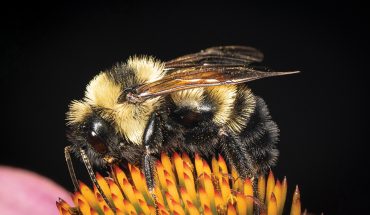by Tony Avent
illustration by Ippy Patterson
It’s not until you come face-to-face – or perhaps I should say nose-to-nose – with a pig butt arum that you realize it isn’t a grand horticultural April Fool’s prank.
Indeed, I was doubtful when I first heard tales of such a plant. So much so that pig butt arum, properly known as Helicodiceros muscivorus, vaulted to the top of my “most wanted” plant list.
I’ve publically admitted to having a penchant for nature’s quirkier plants, so the pig butt arum qualifies on many levels. Indeed, this plant is the horticultural Hunchback of Notre Dame. Grotesquely fascinating to look at and truly offensive to smell while it’s mating. For those who study Latin, the term muscivorus means “fly eating”… how charming!
Finally (this was in 2001), I acquired two plants: One from the local aroid expert Alan Galloway and a second from a European botanical garden with which I swap plants.
The tubers were small, but eventually matured in 2004, when I was able to indulge my olfactory senses. It was immediately clear that the smell of pig butt arum was never designed for rose fanciers. Instead, it’s meant to appeal to insect pollinators by mimicking the dead-animal smell of nearby seabirds, whose hygiene ranks right there with a poorly ventilated outhouse. Indeed, the pungent aroma was exactly what I remembered from childhood, back when I dug for fishing worms in the pig pen.
Back to the plants. I planted one Helicodiceros muscivorus in the shade and one in the sun, only to realize after one season that shade was not its friend. Although the inflorescence, or flower cluster, is the main reason to grow pig butt arum, its foliage is equally fascinating. The bizarre, three-dimensional, glaucous (greyish blue-green), fleshy leaves emerge from an underground tuber in early March, poking through the ground overnight like a zombie from the grave.
The 18-inch tall spikes of unique foliage (which remind me of the Krypton ice castles in Superman I), sit alone until late April, when a green floral tube emerges from the center of the foliage. First, it stands slightly shy of upright, like the flag over Iwo Jima. Then, over the next few days, this floral tube declines to a 90-degree angle, at which time it unfurls to reveal an eight-inch wide, 14-inch long, fleshy section of pig-like skin, replete with appropriate fuzzy hairs.
This pig skin part is known as a spathe, a term most folks know better as “the white part” of pig butt arum’s more socially acceptable cousin, the peace lily.
From the base of this spathe emerges the rest of the plant’s sex organs, known as a spadix, which resembles a hairy brown pig tail – hence the common name. While the smell of Helicodiceros muscivorus only lasts a few hours at its reproductive peak, there should be plenty of time to cut a flower and send it to school with your children for a memorable show-and-tell.
A pig butt arum’s natural home is on a handful of Mediterranean islands: Corsica, Sardinia, and the Balearics, where it can be found growing both along the coast as well as in the adjacent steep rocky cliffs. Consequently, pig butt arum is as well adapted for dry summers as well as for winters as far north as Boston.
Not long after flowering, pig butt arum will go dormant for the summer – unless, of course, the flies were successful in pollinating your plant, in which case you’ll have seed to plant. This is the best way to get more to share with friends (or with your less-than-favorite boss).
We have found pig butt arum very easy to grow, provided you give it four or more hours of sun during its short growing season, and well-drained soils while it’s dormant.
I’ll admit there are few more enjoyable gardening things in life than having a garden club tour when the pig butt arum is in full flower.
For all of you brave gardeners who’d like to give it a try, pig butt arum is available online from specialty nurseries.




